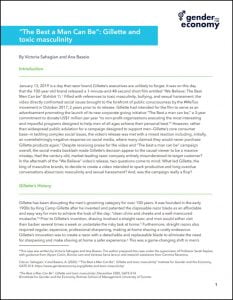Overview
Gillette’s 2019 ad campaign and corporate giving initiative, “The Best a Man Can Be”, aimed to tackle toxic masculinity. It was met with strong reactions of both backlash and support. What led Gillette, the king of masculine brands, to create a campaign intended to spark conversations about this topic? Was it a flop or a success?
Course Topics:
- Marketing
- Gender Analysis
- Diversity and inclusion in business
- Corporate social responsibility
Introduction:
January 13, 2019 is a day that razor brand Gillette’s executives will not soon forget. It was on this day that the 100-year-old brand released a 1-minute-and-48-second short film entitled “We Believe: The Best Men Can Be”. Filled with references to toxic masculinity, bullying, and sexual harassment, the video directly confronts social issues brought to the forefront of public consciousness by the #MeToo movement in October 2017, two years prior to its release. Gillette had intended for the film to serve as an advertisement promoting the launch of their new corporate giving initiative “The Best a Man Can Be,” a three-year commitment to donate $1 million per year “to non-profit organizations executing the most interesting and impactful programs designed to help men of all ages achieve their personal best.” However, rather than widespread public adulation for a campaign designed to support men—Gillette’s core consumer base—in tackling complex social issues, the video’s release was met with a mixed reaction including, initially, an overwhelmingly negative response on social media, where many claimed they would never purchase Gillette products again. Despite receiving praise for the video and “The Best a Man Can Be” campaign overall, the social media backlash made Gillette’s decision appear to the causal viewer to be a massive misstep. Had the century-old, market-leading razor company entirely misunderstood their target customer? In the aftermath of the “We Believe” video’s release, two questions come to mind: What led Gillette, the king of masculine brands, to decide to create a video intended to spark productive and long overdue conversations about toxic masculinity and sexual harassment? And, was the campaign really a flop?

View and download the full case study.
__________________________
This case was written by:
This case was written by Victoria Sahagian and Ana Baseio. The authors prepared this case under the supervision of Professor Sarah Kaplan, with guidance from Alyson Colón, Bonnie Lam and Vanessa Serra Iarocci and research assistance from Carmina Ravanera.







